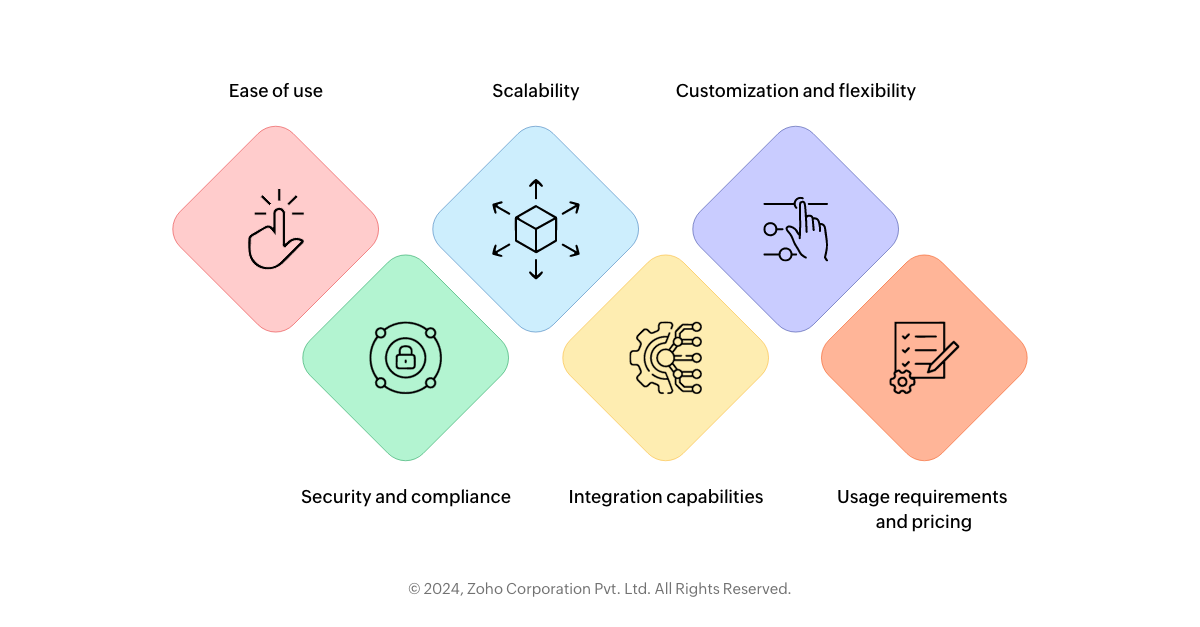Top 6 ways to choose the right low-code development platform
- Last Updated: March 4, 2025
- 89 Views
- 6 Min Read

Choosing a low-code platform for your business shouldn’t feel like a shot in the dark. All low-code platforms may appear similar at first, but in reality, some are far more suited to your business requirements than others. As more businesses tap into the power of low-code, the number of available platforms has exploded. To help you navigate the options and find the best fit, we have put together a list of key factors to consider when selecting the perfect low-code platform for your business needs.
Why is venturing into low-code development necessary?
The evolution of coding is a story of progress. From the first compiled language, Autocode, to some of the most popular programming languages, like C and Python, coding has come a long way.
Fast-forward to today, low-code platforms are changing the game, allowing even non-developers to create powerful apps with ease. This shift democratizes software development, making it accessible to everyone, regardless of technical expertise.
The global low-code development platform market was valued at $41 billion in 2023 and is expected to grow to $388.6 billion by 2030, with a CAGR of 37.9%. These numbers speak for themselves, proving the undeniable impact and potential of low-code development.
Venturing into low-code development is beneficial and comes with several advantages. Low-code simplifies app creation with its drag-and-drop functionality, speeding up time to market. This method automates repetitive processes, which reduces manual errors and boosts efficiency. It is also extremely cost-effective, making hiring full-stack developers optional. In addition, the applications built on these platforms are secure, scalable, and can be easily maintained.
If low-code’s been on your radar but you haven’t jumped in yet, it’s time to take that first step and see how quickly you can turn your ideas into apps.
How to choose a low-code application platform
With so many options available, choosing the right platform can be challenging. It's best to start by assessing your business needs; are you building simple apps for small teams or complex solutions for large enterprises? Understanding the complexity, scale, and type of applications you need to create is key to narrowing down your choices. Here are a few points to keep in mind before choosing your low-code platform.

1. Ease of use
A major benefit of low-code platforms is how they simplify development, making it easier for users with little to no technical experience. Look for platforms that offer user-friendly features like drag-and-drop tools, workflow and page builders, prebuilt templates, and widgets. These tools enable both technical and non-technical users to quickly build and manage apps. The more intuitive the platform, the faster your application hits the market.
2. Security and compliance
Security and compliance are crucial when handling sensitive data. Ensure the platform offers robust data encryption and role-based access controls, and it complies with relevant regulations like the GDPR or HIPAA to avoid legal risks. These features are not only essential for protecting data but also for ensuring your applications meet necessary compliance requirements, keeping your business safe from potential fines or breaches.
3. Scalability
The platform you choose should be able to scale automatically as your business grows. As your app expands, it will need to manage higher traffic, larger data volumes, and potentially more complex features. Select a platform that offers scalability, allowing your app to adapt as your needs evolve. Whether you're increasing your customer base, adding new functionalities, or integrating with other systems, scalability ensures the platform can accommodate these changes without sacrificing performance.
4. Integration capabilities
Effective integration with other tools and systems is essential for smooth operations because it ensures data flows seamlessly across your business, reducing silos, manual effort, and errors. Ideally, your low-code platform should easily connect with your existing software, such as CRM systems, databases, and third-party services. Look for platforms that offer prebuilt connectors, APIs, and customizable integration options to streamline communication between your application and other business systems.
5. Customization and flexibility
Every business has its own unique needs, so customization is key. Ensure the platform offers enough flexibility to adapt to your business processes. This might include the ability to customize workflows, design dashboards, or add new features as your needs evolve. A good low-code platform should allow you to customize both the front-end and back-end of your apps, ensuring they align with your specific requirements.
6. Usage requirements and pricing
Determine the number and type of users who will access the platform and estimate your budget. Some platforms charge based on user count, others charge based on the number of apps, and some use subscription-based pricing. Review the pricing structures and make sure the platform you select aligns with your budget while providing the necessary features and scalability.
Choosing the right low-code platform is crucial for meeting business and technical needs. Focus on parameters like ease of use, security, scalability, integration, and cost to ensure the platform aligns with your long-term goals and boost productivity.
Why ManageEngine AppCreator is the ideal low-code application platform
The number of low-code development platforms available on the market is on the rise, but finding one that ticks all the boxes is still a challenge. That's where we can help you navigate the options.
MangeEngine AppCreator is a low-code application development platform that helps you build custom applications from scratch tailored to fit your business needs. Designed for both technical and non-technical users, AppCreator simplifies app creation through an intuitive drag-and-drop interface and prebuilt templates and workflows, thus making it faster and easier for users to design and deploy apps.
The platform offers a user-friendly interface along with strong security and compliance features, such as role-based access and data encryption, to ensure applications comply with regulatory standards. Whether for simple tasks or complex workflows, AppCreator streamlines application development, reduces costs, and accelerates time to market, making it the ideal low-code platform for businesses.
If you would like to explore the platform further, we invite you to sign up for a free trial and see how it aligns with your business needs.
FAQ
1. How do I evaluate whether a low-code platform meets my organization's needs?
To evaluate a low-code platform, we recommend to assess its:
- Features, such as drag-and-drop interfaces
- Integration capabilities with existing systems
- Scalability
- Security measures
Ensure it can meet both current and future business needs. Test its ease of use for both developers and non-developers, and check for reliable customer support and comprehensive community resources.
2. How do I assess the long-term viability of a low-code platform?
To assess long-term viability, a best practice is to review the vendor's track record and financial stability history. Evaluate the community and ecosystem around the platform, considering user feedback, third-party integrations, and the frequency of updates or new features. A large user base and active support can signal a platform’s viability.
3. What is the typical cost structure of a low-code platform?
Low-code platforms typically follow a subscription-based pricing model. That is, they offer tiers based on the number of users, features, and usage levels. Some platforms may charge based on the number of applications built, data storage, or API calls. Additional costs may apply for premium features, training, or support.
4. How do I ensure my chosen low-code platform complies with industry regulations?
To ensure compliance, review the platform’s certifications (e.g., GDPR, HIPAA, ISO 27001, etc.) and assess its data storage practices, security protocols, and privacy measures. Engage legal teams to verify compliance with industry regulations. Ask the vendor for relevant documentation, such as audit reports or certifications, to ensure the platform aligns with standards specific to your sector.
5. Do vendors offer a free trial or proof of concept before purchasing?
Yes, many low-code platforms offer free trials or proof of concept options, allowing users to explore features, test functionality, and evaluate the platform’s suitability before making a purchase. This helps businesses make informed decisions without immediate financial commitment.
6. What should I test during a demo or free trial to ensure the platform is the right fit?
During a demo or trial, we recommend users evaluate user-friendliness, ease of building and deploying applications, customization options, and the platform’s ability to integrate with your existing tools. Test for scalability, security features, performance under load, and customer support responsiveness.




